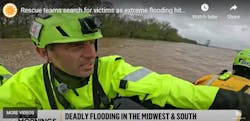ICE RESCUE/COLD WATER RESCUE EQUIPMENT
All personnel operating at the Awareness level should be provided with appropriate Personal Flotation Devices (PFDs) or Anti-Exposure Coveralls to protect them from the elements and any unintentional entries into the cold water. They can also be trained in the use and have available certain shore-based rescue equipment including rescue throw bags, heaving lines, or other specialty equipment designed to be deployed from shore.
The following is a description of personal protective and basic rescue equipment suitable for use by Awareness level rescue personnel for performing shore-based rescues:
PERSONAL FLOTATION DEVICES (PFDS)
PFDs are approved by the U.S. Coast Guard and are classified into 5 types. Type I and Type II PFDs are typically not suitable for use by rescue personnel as wearable devices as they are cumbersome and reduce mobility by the wearer. However, they are excellent for use by the victim, before rescue personnel attempt to remove the victim from the hazard. Type III PFDs come in a variety of designs and intended purposes and are the most suitable for use by rescue personnel. A Type IV is a throwable device which may be appropriate for use to slide along the ice or to throw to a victim in the water. A Type V PFD is a special-use PFD or an inflatable PFD.
RESCUE THROW BAG
Rescue throw bags should have a minimum of 70 feet of 5/16" or 3/8" line stuffed inside a bag. The rescuer holds one end of the line and throws the bag to the victim. The line deploys out of the bag when the bag is thrown. The difficulty in using equipment such as this is not in the ability of shore-based rescue personnel to deploy the equipment, but rather, in the ability of the victim to effectively hold onto the device, due to their physical and/or emotional condition. When using a rescue throw bag, the victim must be instructed to wrap himself in the line before an attempt is made to pull the victim to shore.
RESCUE RING
The rescue ring can be slid along the ice to a victim in the water. It is designed to close around the victim when tension is applied to the lifting ring. This product is significantly superior to a regular ring buoy when rescuing weak or unconscious victims.
The following is a description of equipment suitable for use by Technician level rescue personnel for "go" rescues, both on the ice and in the water:
COLD WATER/ICE RESCUE SUITS
These are one-piece heavy neoprene rubber suits designed for fast and easy donning. Suits have integrated five-fingered gloves, a hood, and rigid-sole boots. Other features include reinforced knee and elbow pads and an integral chest/back harness for attaching tether lines. These suits are designed to keep the wearer warm, afloat and dry in cold water. Tether lines should be attached to the chest of the rescuer during ice rescue incidents, while for open water incidents, rear tether line attachment is acceptable.
DRY SUITS
Dry Suits are only designed to keep the wearer dry. When using dry suits, the rescuer must wear an under layer of fleece for warmth, and a PFD over the dry suit for buoyancy. The advantage of dry suits over Cold Water/Ice Rescue Suits is that the wearer has more dexterity and freedom of movement which is critical in moving water environments, when handling rope lines, or during more technical rescue operations. Many Dry Suits do not come with integral boots or gloves, so these need to be included as well. The attachment of a shore-based tether line is typically done with the PFD, or with an external harness system.
ICE PICKS
Commercial ice picks can be purchased or rescuers can improvise their own using wooden dowels and screws. These devices are excellent for assisting the rescuer to pull himself across the ice to the victim and are especially useful for self-rescue should the rescuer fall through the ice. The commercial ice picks are constructed of a plastic shaft, a plastic retractable sheath, and a metal pick. When the ice pick is driven onto the ice, the sheath retracts exposing the metal pick.
INFLATABLE PFDS
Once the rescuer makes contact with the victim, he/she can activate the inflatable PFD to provide an additional 25 - 35 lbs. of buoyancy. Because these PFDs are cumbersome when deployed, they should only be inflated after the rescuer makes contact with the victim.
ICE CLEATS
Ice cleats are fitted over boots to provide additional traction for rescue personnel while walking or crawling on ice and snow. Care must be taken in selecting the appropriate type of cleats to be sure they will stay on the foot while walking in deep snow, while walking on ice, and while immersed in water.
WATER RESCUE ROPE AND BAG
The length of rope required depends on the location, but a floating line specifically designed for use in the water and stuffed inside a standard rope bag should be available to attach to rescue personnel, as a shore-based tether line, before they venture out onto the ice to attempt a rescue. Once the rescuer contacts the victim, rescuers on shore can pull the victim and rescuer back to shore using the tether line. Rescue personnel should never venture out onto the ice without being tethered to shore, or tethered to a piece of buoyant rescue equipment, which is then tethered to shore.
RESCUE BUOY
Whenever possible, the rescuer should always try to keep some type of buoyant device between himself and the victim. The device should also assist the rescuer in maintaining a firm grasp on the victim while they are being pulled to shore.
RESCUE SLING
A commercial 48" sewn sling can be used to fasten a "Fast-Sling" around the victim to provide a good hand-hold for the rescuer. A make-shift sling can be prepared by tying the two ends together of a 60" piece of 1" webbing. As the rescuer advances towards the victim, he slips the sling over the victim's shoulders before attempting to drag him onto solid ice.
ROOF OR EXTENSION LADDER
A standard roof ladder is ideal for assisting the rescuer to distribute his weight across the ice and to serve as an extension device to extend to the victim in the water. Depending on the depth of the water, one end of the ladder can also be dropped into the water as an aid for the rescue personnel and victim to climb out of the water.
BASKET STRETCHER WITH FLOTATION COLLAR
Most fire departments have basket stretchers within their rescue equipment inventory. A backboard should be placed and secured inside the basket stretcher and a flotation collar should be attached to the upper half of the basket. This allows the foot of the basket to be sunk below the victim and the victim can then be slid into the basket stretcher. The basket stretcher will also help to equalize and distribute the rescuer's weight across the ice as he approaches the victim. If the rescuer falls through the ice, he then has a buoyant platform for safety. When the victim needs to be removed from the basket, the backboard is removed with the patient secured to the backboard.
BACKBOARD
The use of a standard backboard will help distribute the weight of the rescuer while progressing across the ice. They are ideal for use by the rescuer to slide across the ice towards the distressed victim. Once the rescuer reaches the victim, the board can be used as an extension device, or the rescuer can slide the board under the victim and then have shore-based rescuers tow the victim to safety.
PIKE POLE
A standard pike pole can help distribute the rescuer's weight across the ice while approaching the victim. When within reach of the victim, the rescuer can use the pike pole to snag the victim to pull the victim out of the water. If the victim is submerged, the pike pole can be used to attempt to locate and snag the victim from the bottom or just under the sheet ice layer.
WATER RESCUE JAWS
The Water Rescue Jaws is a reach pole that extends to 18' that will grab and hold a victim until he can be pulled to the surface. A short downward thrust opens the "J" shaped tongs to a width of 42 inches. When downward motion stops, the tongs automatically close. As a victim is lifted to the surface, the upward movement through the water, along with the force of gravity, keeps the tongs closed, securely grasping the victim.
INFLATED FIRE HOSE
An end cap is attached to one end of one, or several hose sections, while an end cap with an air chuck valve tapped into it is attached to the other end. The hose is inflated to approximately 30 - 100 psi. This makes an excellent buoyant device for rescue personnel and the victim. The hose can also be wrapped around a 14' roof ladder which makes an excellent flotation platform. In an emergency, the hose can be inflated with a CO2 fire extinguisher with the ends of the hose folded and tied off with webbing.
RESCUE BOAT
Any type of flat-bottom boat is suitable for use on the ice to help distribute the weight of the rescuer and victim, and to serve as a buoyant platform should the rescuer fall through the ice. Boats are also excellent to progress through open water. The Oceanid RDC (Rapid Deployment Craft) inflates using a standard fire department SCBA bottle. This device has an opening at both ends (front and back) of the boat. The rescuer can slide the RDC across the ice or paddle it using a canoe or kayak paddle in open water. One end of the RDC is placed directly over the victim and the victim is then pulled up and onto the inflatable platform deck of the device. In lieu of a flat bottom boat, any canoe or kayak can also be used as well.
RESCUE SLED
A variety of commercial sleds (Lifesaver Ice Rescue Sled or Rescue Alive) are available. They provide a stable platform on the ice and in the water. The Rescue Alive unit can be collapsed and easily stored on an apparatus and rapidly deployed at the scene of an Ice Rescue incident.
BOOGEY BOARDS OR SNOW BOARDS
An inexpensive boogey board or snow board helps the rescuer distribute his weight across the ice, and because of the slick flat bottom, the rescuer can rapidly advance towards the distressed victim. Should the ice break, the board provides an excellent flotation platform for the rescuer and the victim. The board can also be used to progress through open water if necessary.
INFLATABLE KAYAK/PADDLEBOARD
An inflatable kayak is an excellent and relatively inexpensive device for providing a means by which to distribute the weight of the rescuer and victim, and provide excellent buoyancy in the water for both.
LINE DEPLOYING GUNS/ROCKETS
Line deploying guns are excellent to deploy lines for technical water and ice rescue operations. If concurrent rescue methods are attempted, the line gun provides one means by which to coordinate efforts allowing for one team to tether to the other team to assist in their progress towards the victim.
With the use of any equipment, both the rescuer and the equipment should be tethered and manned by shore-based rescue personnel. At no time should the tether lines ever be attached to a vehicle!





